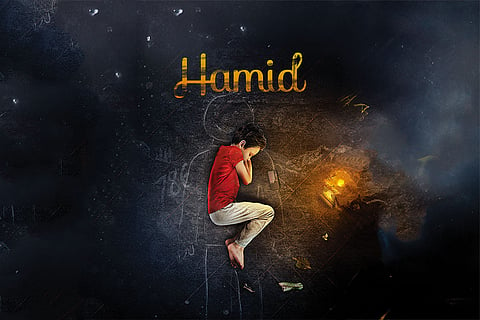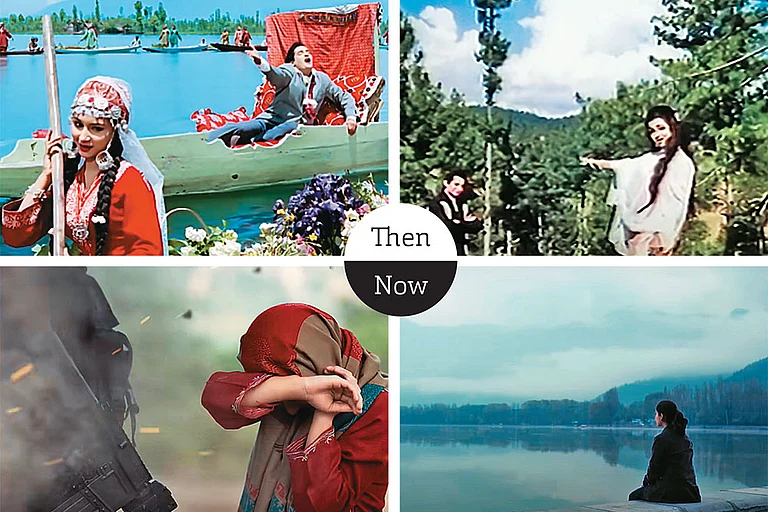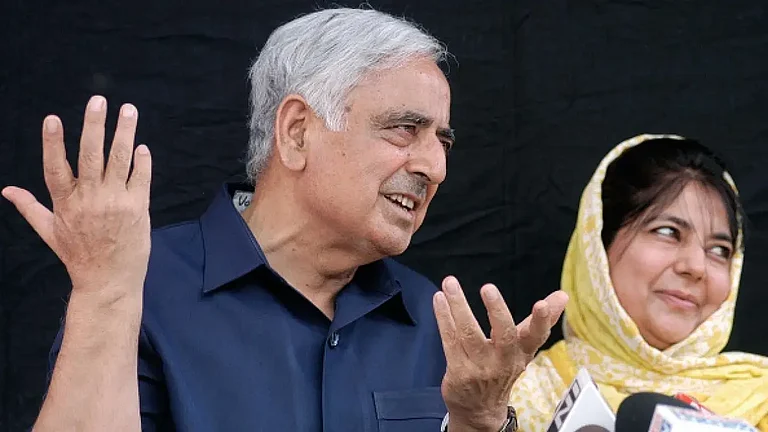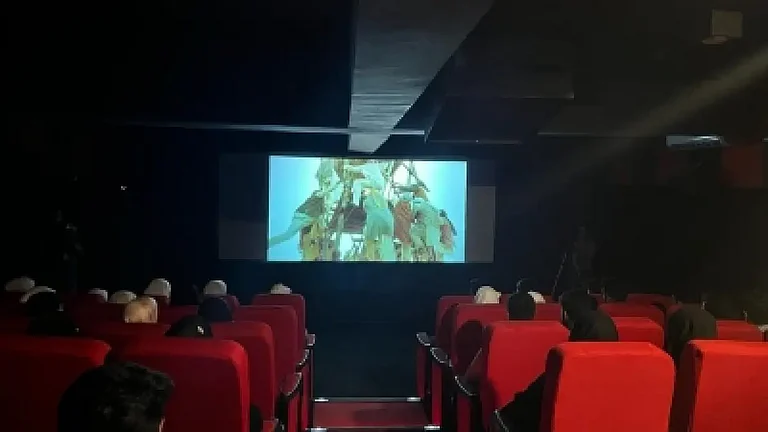This story was published as part of Outlook Magazine's 'Future Tense' issue, dated October 11, 2024. To read more stories from the Issue, click here.
Kashmir Chronicles: A Cinema In The Offing
While Bollywood capitalises on Kashmir, the regional film industry struggles to find financial support
“Do you believe there is still a demon here?” Asifa asks.
“No,” says Gulzar.
“So what’s the problem now?” she wonders.
“There are no more saints,” he quietly replies.
—Valley of Saints, 2012
The air in the Valley is besieged by the dust storm that the assembly elections have kicked up in the last month. Jammu & Kashmir sees its first assembly election in ten years—its significance tied to the rescinding of J&K’s special status after the abrogation of Article 370. Some are promising a return to normalcy; others say, it is already normal.
Where does one go to unearth the truth in a fragmented place? To a constellation of images; a metaphor. To find Kashmir, one must look in the fragments; not in reports, speeches or slogans. Kashmir changes, yet remains unchanged—and only cinema can grasp this flux.
Militarisation and political turbulence are enduring backdrops in the precious few Kashmiri films that have been made in the past seven decades. Valley of Saints (2012), directed by Musa Syeed, is set in the milieu of the 2010 unrest—following the staged encounter of three Kashmiri youths by the Indian armed forces in Baramulla. In a story about love and longing, the impasse becomes the barbed wire in which the protagonists are trapped.
“No time for love”—a board reads, propped atop a shikara, steered along the Dal Lake by Gulzar (Gulzar Bhat), the pensive protagonist in Valley of Saints. The message stands in for the lingering sentiment in the film and its space—love is difficult to come by in a region so deeply embroiled in conflict. The Dal Lake, a central character in the narrative, is an allegory of Kashmir, both in its beauty and imperilment.
While J&K’s natural beauty has served as an aesthetic background in several Bollywood blockbusters, the region has a tragically underdeveloped homegrown film industry. Among the handful of Kashmiri filmmakers who have managed to produce these films, most belong to the Kashmiri diaspora, including Syeed who is American-born. Over the years, migration of the native Kashmiri population outside the Valley persists due to the never-ending political turmoil marring daily life. This underlying dilemma also determines the story in Valley of Saints. Exhausted with a life punctuated by curfews and violence, Gulzar wishes to run away from Kashmir with his childhood friend Afzal (Mohammed Afzal). But a new-found love holds him back. Ultimately, he must choose between chasing his dreams and staying behind.
Some filmmakers did stay behind. But their choice came at a heavy cost. Aarshad Mushtaq, whose Akh Daleel Loolech (2006) was Kashmir’s first digital film, recalls how his announcement of the digital circulation of his film through VCDs and DVDs was derided. “It was very difficult to make films in Kashmir till 2000. Only after the onset of digitalisation did filmmaking become slightly accessible”, he says. When asked about the state of the Kashmiri film industry, he said, “In Kashmir, certain institutions are not allowed to grow at the level of policy making. The hidden agenda becomes clear when you see technical colleges coming up, which push the growth of a mechanical workforce. But liberal institutions that can foster critical thinking like art, theatre or film schools, are not met with the same enthusiasm by the government.”
Kashmir changes, yet remains unchanged—and only cinema can grasp this flux.
Mushtaq’s film is a historical drama set in the 19th century, based on the oppression of the local populace by Dogra rulers during a famine. Kashmiris struggled to cope with exorbitant taxes and bonded labour under their regime. Set against this backdrop is the love story of a village boy and a feudal landlord’s daughter. Mushtaq rues that there are no financial resources available to produce Kashmiri cinema. According to him, even centres set up by the government to support such efforts like Doordarshan, Radio Kashmir or Academy of Art, Culture and Languages, often assume the role of “censor boards” with local narratives. “The earliest Kashmiri language film, Mainz-Raat (1964), was directed by Jagi Rampaul, a Punjabi. How many Kashmiri filmmakers are provided financial assistance by the State? Any support comes with the expectation that no difficult questions will be asked in these films,” he says.
On the other hand, the BJP-led Central government has been keen to redirect the interests of Bollywood towards the locales of J&K after the abrogation. While unveiling the J&K Film Policy 2024 at the J&K Film Conclave recently, Lt Governor Manoj Sinha said, “J&K and cinema are a symbol of oneness and cannot be seen separately. They are a perfect match. For great filmmakers like Raj Kapoor and Yash Chopra, J&K was not only a shooting destination but also a cultural organism.” Incentivising film shoots for both domestic and international productions and promoting “film tourism” seems top priority. However, it remains to be seen whether this new policy will actually benefit the regional industry in producing more films in Kashmiri languages. According to Mushtaq, these moves are meant to sell the narrative of Kashmir’s ‘development’ elsewhere for the sake of votes. But they do little to address the woes of the regional industry.

So far, the boost for Mumbai’s film fraternity has done little to heal the wounds that have festered in Kashmir’s association with cinema. Due to the rising militancy, cinema theatres across the region were shut down in 1989. With the burgeoning presence of the Indian armed forces, newer infrastructure was required to carry out military operations. As a result, many cinema theatres in J&K were converted into interrogation and detention centres and horror stories began to emerge from these sites, which were once a source of joy for Kashmiri people.
The Hindi films that were made on Kashmir in the following decades added further fuel to the fire. Films like Roja (1992), Mission Kashmir (2000), LOC Kargil (2003), Fanaa (2006) and more recent ones like Uri: The Surgical Strike (2019), Shikara (2020), The Kashmir Files (2022) and Article 370 (2024) have consistently galvanised the image of Kashmiri Muslims as terrorists. Vishal Bhardwaj’s Haider (2014), which attempts to capture the plight of Kashmiris with more nuance and sensitivity, has been a rare exception. While earlier Hindi cinema like Junglee (1961), Kashmir Ki Kali (1964), Kabhi Kabhi (1976) and Betaab (1983) exoticised the Valley and sanitised the location of its conflicts, the later films have demonised the local populace. This has led to further bitterness in the community and made them wary of Bollywood’s depiction of Kashmir.
Some Kashmiri filmmakers have tried to circumnavigate Kashmir’s political quagmire by making films that mimic Bollywood’s style of production. Their narratives are bereft of any engagement with the conflict and end up as B-grade movies with low production quality. Hussein Khan’s Kashmir Daily (2017), made in Hindi and Urdu, is one such example. Though well-intentioned in its attempt to address Kashmir’s internal struggles with unemployment and drug abuse, the film is not only abysmal in terms of its production, but also skewed in the region’s overarching representation. “The tragedy of Kashmiri cinema is that the few filmmakers who are attempting to produce films are not looking inwards at Kashmir’s rich literary and theatrical traditions for inspiration. Instead, they rely on news reportage and second-hand accounts to make films, which impacts the overall capability of such cinema to truly embody Kashmiri culture,” Mushtaq says.
However, there is some hope in the popularity of OTT platforms that have successfully transcended the barriers of language by offering world cinema to diverse audiences. Aamir Bashir’s Harud (2010), Danish Renzu’s Half Widow (2017), Aijaz Khan’s Hamid (2018) and Ashvin Kumar’s No Fathers in Kashmir (2019) work towards humanising the depiction of Kashmiris and treating the region’s complex socio-historical tapestry with respect. Limited censorship on these streaming platforms allows for greater artistic freedom and critical insight in such cinema. The narratives of these films rise above the hysteria of “Islamic terrorism”, which has otherwise become a staple in Bollywood’s imagination of Kashmir. Instead, a gentler, reflective film form is adopted, inspired from global film cultures like Iranian cinema. The deeply moving Kashmiri music in these movies speaks volumes about the collective memory and identity of a people who have lost so much across generations.
Such cinema is often characterised by uncertain and poignant endings. How much longer will Kashmiris suffer? What kind of futures can they imagine for themselves? What will bring a decisive end to the relentless turmoil? It is in these reflections that such films offer, where a new language of Kashmiri cinema is waiting to be born.
(This appeared in the print as 'Celluloid Blues')



